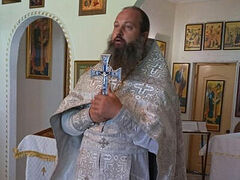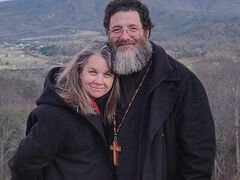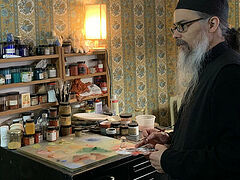Many flights arrive at Puerto Rico airports at night. Florida and Bermuda, Cuba and Jamaica, Haiti and the Dominican Republic remain far out in the ocean.
Once the ground becomes visible, the plane starts descending. The lights clearly outline the contour of the island, and you can already discern the location of each city and town. Here is San Juan, the capital on the Atlantic coast, which is 500 years old. Here early in the morning, right in the center, you can walk along the coast of the turquoise ocean, lean against the old stone walls covered with moss, and go up the paved streets to the Catholic Cathedral in honor of St. John the Baptist, the oldest cathedral on the island and in the USA.
There is San German in the middle of the island—its second largest and second oldest town—450 years old. Fr. Gregorio Justiniano returned here after living in the USA for almost a quarter of a century. He returned to introduce his compatriots to Orthodoxy, which had been represented on the island only by a church of the Patriarchate of Antioch, which caters mostly to newly arrived Arabic-speaking parishioners. Fr. Gregorio organized a Spanish-speaking Mission in Puerto Rico for those who were born and live here.
And before he became acquainted with Orthodoxy, which happened in America, Hamilton Justiniano had been a Protestant pastor and (in Puerto Rico) the rector of the Pentecostal Seminary in San Juan.
 Archpriest Gregorio Justiniano
Archpriest Gregorio Justiniano
—Father Gregorio, tell us about your childhood, your family.
—My childhood was typical. I was born to a poor family and was the youngest of four brothers. My father was a Catholic, but he didn’t go to church. My mother, a very beautiful woman, never had a formal education, and my father had not gone past the third grade. My father was in relationship with my mother while married to another woman, and we lived in the same city with their children and her children by another man. You can imagine that our relations were complicated. My mother died prematurely—she was only fifty-six.
As for my education, at that time we didn’t have many books in our house, and because of our poverty education in the family was not a priority. We had to earn our crust of bread and make ends meet somehow.
I fell in love with my future wife when we were very young, and once I graduated from high school we got married.
 Hamilton Justiniano (right). The late 1950s
Hamilton Justiniano (right). The late 1950s
I had always wanted to study, but I couldn’t afford it. I asked my father if he could help me pay for my university tuition, but he refused.
We had been married for five years when I decided to quit my job and go to the American University in San German.
At that time in the town of Sabana Grande, not far from us a Pentecostal mission was opening (the denomination is called the Assemblies of God), and I was invited there as a pastor with a salary of $75 per month. At the same time, I received a scholarship from the university, and the Government helped us with a food allowance. That’s how we kept going.
 San German. The cathedral in the center
San German. The cathedral in the center
—Was this way of life typical of Puerto Ricans at that time?
—Yes, there were only a handful of rich people in Puerto Rico in the 1950s and the 1960s. Few people had cars, and most of them would get to the city center on foot. Well-to-do people lived in San German around the Catholic church and the square in beautiful buildings. Most of the people were engaged in agriculture and worked on coffee and sugar plantations. In the 1980s government policies changed: sugar cane was no longer grown, pharmaceutical companies came to Puerto Rico, and tourism began to develop actively on the island.
I could never study full-time at university, and deep in my heart I dreamed the time would come when we would be able to send our children to colleges, where they would live on campuses with their fellow students. So the desire to give a good education to our children was one of the reasons why we moved from Puerto Rico to the USA. Thank God, all my children lived on campuses and graduated from universities.
 San German. Old streets in the center
San German. Old streets in the center
—How did you move to the USA, and how did your new life begin?
—When we moved to the USA, we didn’t know anything about the country except what we had read about in newspapers. We took up residence in the city of Danbury, Connecticut in the north of the USA, where we lived for twenty-four years.
At that time I could read and write in English, but I could hardly speak the language. And when you emigrate to another country, it is necessary to speak. At first I started working as a dishwasher, despite the fact that I had a higher education and a master’s degree.
The first years are always very tough for immigrants. We couldn’t find an apartment for a long time. We did not get any support from the State. Then I began to work at a printing house. My wife was raising our four children and was unemployed. Then I worked for an auto parts company. After our children had begun to go to school, my wife found a job as well.
In Puerto Rico she studied to be a nurse, but after we got married and our first child, Despina, was born, she decided to devote herself to raising children.
When we moved to the USA, my wife decided to continue working as a nurse. She studied late at night for a year, then passed the exam and got permission to work.
At that time I worked at an agency where I assisted immigrants who did not know English in their studies. I worked there for a year or so, and when the director of the agency quit, I was offered his place. At the same time, I applied for a master’s degree and planned to teach Spanish-speaking students at school. I would study in the evenings when I finished working at the agency. I would travel to Hartford for classes, and sometimes I studied at home, even at night. When I obtained my master’s degree, I was offered a position as a bilingual teacher for Spanish immigrants at Danbury High School, where I worked for twenty years. The students did not know English at all, and a group of teachers and I taught them basic subjects in Spanish: mathematics, natural sciences, history and social studies. In parallel, we would learn English with them. Subsequently, some of those students even entered universities.
It was at that school that I first met an Orthodox priest from the Antiochian St. George’s Church next door to the school. He served as a paid priest, but the school was so large that every day they needed many teachers who would cover for other teachers. And there he worked part-time.
I noticed right away that he didn’t look like a Catholic priest. It turned out that he was Orthodox, and his name was Fr. Timothy Cremeens. We started meeting almost every day, and I asked him questions. This went on for about a year. He was glad that I wanted to convert to Orthodoxy. From that moment on we began to meet every Wednesday, and he explained the basics of Orthodoxy to me. I would also come to Vespers, and the parishioners did not know that I was a Pentecostal pastor. I couldn’t attend the Liturgy because I would preach in the Pentecostal church in the morning.
 Igumen Silouan (left) and Hieromonk Daniel
Igumen Silouan (left) and Hieromonk Daniel
While we were being introduced to Orthodoxy, I asked my son, Fr. Silouan (at that time he was still Hamilton, like me), to go to the Liturgy at St. George’s Church and then tell me what it was like.
“Everything is different there, completely different,” my son told me. At the church he saw icons for the first time, smelled incense for the first time, and was absolutely amazed.
I had a very hard time, because I began to realize that this is the Church that I had always wanted to know about—the Orthodox Church. I first met Fr. Timothy in 1995. In 1996, I decided to quit my job at the Assemblies of God church.
But how could I leave the Pentecostal Church and join the Orthodox Church without divorcing my wife and losing my children?
My wife Euphemia has always taken her faith very seriously. She had never been a Catholic and had never converted to Protestantism like many in Puerto Rico. The only religion she had ever known was Pentecostalism. Before moving to the USA, for five years I had been a pastor of a Pentecostal church and the rector of a Bible Institute that trained pastors in the country’s capital of San Juan.
I began to tell her about the reasons for my desire to become Orthodox and tried to convince her that by embracing Orthodoxy we would become closer to the Lord.
—What were the things that didn’t satisfy you in the teaching of the Pentecostals?
—I had problems regarding their understanding of the sacrament of Eucharist. This is one of the reasons that prompted me to seek the Orthodox Church. I could never accept the way they took Communion, and I never called it the Holy Gifts, even if they took Communion with pure hearts. I myself took Communion with a pure heart; however, for some reason I felt and understood that there was something missing in that Communion, but I could not find an answer.
As part of training Fr. Timothy invited me to a meeting of the clergy of the Church of Antioch, where I saw for the first time how the Divine Liturgy is celebrated and Holy Communion is administered to communicants with a special spoon. I wept so much that my glasses were very wet. It was a mixture of happiness and holiness—exactly what I had been looking for for a long time.
So, I decided to leave the Pentecostals, told my wife about it and tried to find a way for our family to embrace Orthodoxy.
My wife has a heart of gold. She supported me and went through this difficult time with me. But we lost everything: our salaries, friends, reputation and even our relatives.
 The mission of the Assemblies of God church in Sabana Grande
The mission of the Assemblies of God church in Sabana Grande
—What was the reaction of your fellow Pentecostals when you left?
—I was responsible for the Latin American ministry and pastored the huge American community of the Assemblies of God between Danbury and Brookfield in Connecticut. When I was about to leave the Pentecostal Church, I met with the senior pastor of the community and asked him to let me preach my last sermon. It was in August 1995. I told the congregation that it was my last sermon and that I had already been baptized in the Orthodox Church. I explained to them that my decision to leave the Assemblies of God was caused by the desire to grow spiritually and the conviction that the Orthodox Church is the true Church of Christ. I did not want to cause division in the mission and suggested that they try to find the truth in their own hearts.
Ten young men from that parish followed me to the Orthodox Church. They were baptized and still attend the Orthodox church.
A few years later I was invited to an anniversary of that Pentecostal Mission and asked to speak to the entire congregation of Americans and Latin Americans. I did not preach, but while congratulating them, I tried to find the kindest and right words for them. I did not want to confuse or divide the mission members, because I am convinced that only the Holy Spirit, God Himself, can bring people to Orthodoxy.
At that time my son Hamilton was studying at the School of Visual Arts in New York.
He was there alone, and there was hardly anyone to learn about Orthodoxy from. After receiving a Bachelor of Fine Arts degree, he began studying at Hunter College for a master’s degree. But he prepared thoroughly and was baptized even before me—on Pascha. The whole family attended the Baptism ceremony and stayed for the night service at the Chapel of St. Mary Magdalene at Columbia University in New York. After his first year at college he needed a place to live, and the Monastery of St. Mary of Egypt (also known as Mercy House) offered him a room. There, little by little, communicating with the abbot, he became interested in monastic life and later began to live at this monastery as a monk.
—Who was baptized after him in your family?
—I was the second. In October of the same year, Fr. Timothy baptized me at St. George’s Church in Danbury. After the catechism course my wife was received by Chrismation on December 24, together with my son, who is now Deacon Seraphim, and then our daughter Despina was baptized. Lastly, our son Israel (now Hieromonk Daniel) was chrismated.
 Israel Justiniano (the future Hieromonk Daniel) on Broadway
Israel Justiniano (the future Hieromonk Daniel) on Broadway
—His conversion to Orthodoxy was extraordinary...
—Yes, it was. He went through September 11, 2011, when the twin towers collapsed in the center of New York after the attacks. He worked for a company that rented a building just opposite the twin towers. It was a company that produced Broadway shows, and he worked there in a production called Splash. After September 11, the company closed.
—Father Daniel is a very gifted person, and he had interesting professions...
—After graduating from Yale University in New Haven, Connecticut, he became a graphic designer for books and was invited to work at Columbia University Press. He was satisfied with his work and had a good salary. Once he finished a book, he would send me a signed copy with his secular name—Israel Justiniano. Then he worked at the Metropolitan Museum of Art in New York, where he did research and prepared promotional materials for exhibitions: books, catalogs and souvenirs. His work brought him joy, and he often invited his mother and me to exhibitions.
One day he called me and said he was going to work at… Broadway, at the theater. He went to the audition, and he was invited to the grandiose Splash production. Later we watched it: he danced and sang there. It was awesome.
—It must have been amazing experience for him...
—It was a part of his life. And then, after September 11, the company canceled the show. They said that anyone who wanted to continue working at the company would have to move to California or look for another job. He moved with the company. One day during training he fell and injured his back. The doctors said that the condition was not extremely bad, but he should not train for six months. The company didn’t fire him, but could not pay him for six months, so our son decided to return home to Connecticut.
 Future Fr. Gregorio with Metropolitan Nicholas and Priest Luke Mihaly
Future Fr. Gregorio with Metropolitan Nicholas and Priest Luke Mihaly
By that time we were all Orthodox. One day we invited him to a meeting of clergy in Harrison, New York. The head of the Carpatho-Russian Diocese in America, Metropolitan Nicholas (Smisko), spoke there. Later he would ordain me priest.
My son heard his sermon, in which he spoke about the tragedy of September 11. Those words touched his heart, and from that time on he began to attend the Holy Trinity Church in Danbury, of which we were parishioners at that time. Our son talked on spiritual subjects with the rector, Priest Luke Mihaly. So he decided to convert to Orthodoxy and was chrismated in 2002.
To be continued…





